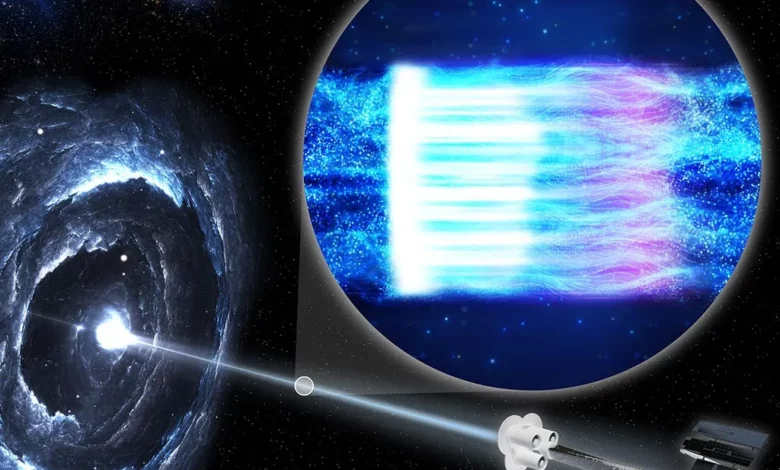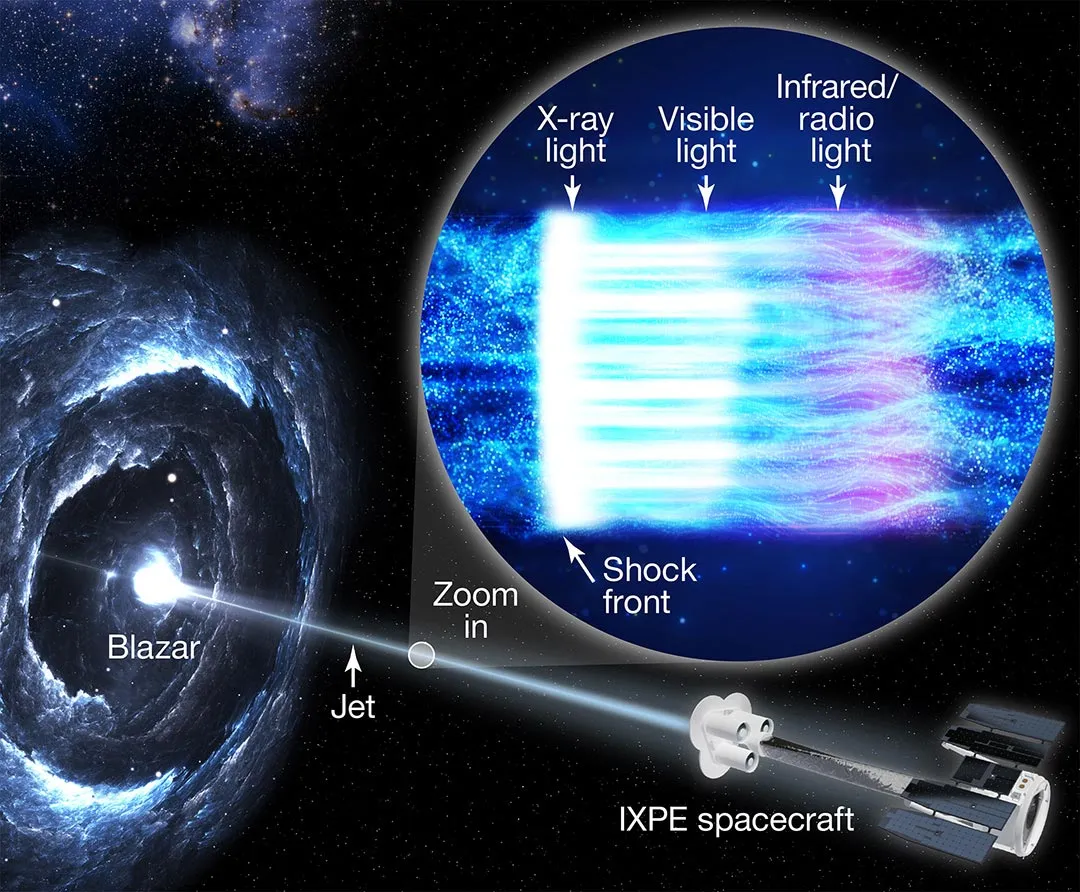
This illustration shows NASA’s IXPE spacecraft, at right, observing blazar Markarian 501, at left. A blazar is a black hole surrounded by a disk of gas and dust with a bright jet of high-energy particles pointed toward Earth. The inset illustration shows high-energy particles in the jet (blue). Credit: NASA/Pablo Garcia
Blazars are some of the brightest objects in the cosmos. They are composed of a supermassive black hole feeding off material swirling around it in a disk, which can create two powerful jets perpendicular to the disk on each side. A blazar appears especially bright from the perspective of our telescopes because one of its powerful jets of high-speed particles points straight at Earth. For decades, scientists have wondered: How do particles in these jets get accelerated to such high energies?
NASA’s Imaging X-Ray Polarimetry Explorer, or IXPE, has helped astronomers get closer to an answer. In a new study that was published on November 23 in the journal Nature, authored by a large international collaboration, astronomers find that the best explanation for the particle acceleration is a shock wave within the jet.
“This is a 40-year-old mystery that we’ve solved,” said Yannis Liodakis, lead author of the study and astronomer at FINCA, the Finnish Centre for Astronomy with ESO. “We finally had all of the pieces of the puzzle, and the picture they made was clear.”

Launched on December 9, 2021, the Earth-orbiting IXPE satellite, a collaboration between NASA and the Italian Space Agency, provides a special kind of data that has never been accessible from space before. This new data includes the measurement of X-ray light’s polarization, meaning IXPE detects the average direction and intensity of the electric field of light waves that make up X-rays. Information about the electric field orientation in X-ray light, and the extent of polarization, is not accessible to telescopes on Earth because the atmosphere absorbs X-rays from space.
“This is a 40-year-old mystery that we’ve solved. We finally had all of the pieces of the puzzle, and the picture they made was clear.” — Yannis Liodakis
“The first X-ray polarization measurements of this class of sources allowed, for the first time, a direct comparison with the models developed from observing other frequencies of light, from radio to very high-energy gamma rays,” said Immacolata Donnarumma, the project scientist for IXPE at the Italian Space Agency. “IXPE will continue to provide new evidence as the current data is analyzed and additional data is acquired in the future.”
The new study used IXPE to point at Markarian 501, a blazar located aproximately 450 million light years away from Earth in the constellation Hercules. This active black hole system sits at the center of a large elliptical galaxy.
IXPE watched Markarian 501 for three days in early March of 2022, and then again two weeks later. During these observations, astronomers used other telescopes in space and on the ground to gather information about the blazar in a wide range of wavelengths of light including radio, optical, and X-ray. While other studies have looked at the polarization of lower-energy light from blazars in the past, this was the first time scientists could get this perspective on a blazar’s X-rays, which are emitted closer to the source of particle acceleration.

“Adding X-ray polarization to our arsenal of radio, infrared, and optical polarization is a game changer,” said Alan Marscher, an astronomer at Boston University who leads the group studying giant black holes with IXPE.
Scientists found that X-ray light is more polarized than optical, which is more polarized than radio. But the direction of the polarized light was the same for all the wavelengths of light observed and was also aligned with the jet’s direction.
After comparing their information with theoretical models, the team of astronomers realized that the data most closely matched a scenario in which a shock wave accelerates the jet particles. A shock wave is generated when something moves faster than the speed of sound of the surrounding material, such as when a supersonic jet flies by in our Earth’s atmosphere.
The study was not designed to investigate the origins of shock waves, which are still mysterious. But scientists hypothesize that a disturbance in the flow of the jet causes a section of it to become supersonic. This could result from high-energy particle collisions within the jet, or from abrupt pressure changes at the jet boundary.
“As the shock wave crosses the region, the magnetic field gets stronger, and energy of particles gets higher,” Marscher said. “The energy comes from the motion energy of the material making the shock wave.”
As particles travel outward, they emit X-rays first because they are extremely energetic. Moving farther outward, through the turbulent region farther from the location of the shock, they start to lose energy, which causes them to emit less-energetic light like optical and then radio waves. This is analogous to how the flow of water becomes more turbulent after it encounters a waterfall – but here, magnetic fields create this turbulence.
Scientists will continue observing the Markarian 501 blazar to see if the polarization changes over time. IXPE will also investigate a broader collection of blazars during its two-year prime mission, exploring more longstanding mysteries about the universe. “It’s part of humanity’s progress toward understanding nature and all of its exoticness,” Marscher said.
Reference: “Polarized blazar X-rays imply particle acceleration in shocks” by Ioannis Liodakis, Alan P. Marscher, Iván Agudo, Andrei V. Berdyugin, Maria I. Bernardos, Giacomo Bonnoli, George A. Borman, Carolina Casadio, Vi´ctor Casanova, Elisabetta Cavazzuti, Nicole Rodriguez Cavero, Laura Di Gesu, Niccoló Di Lalla, Immacolata Donnarumma, Steven R. Ehlert, Manel Errando, Juan Escudero, Maya Garci´a-Comas, Beatriz Agi´s-González, César Husillos, Jenni Jormanainen, Svetlana G. Jorstad, Masato Kagitani, Evgenia N. Kopatskaya, Vadim Kravtsov, Henric Krawczynski, Elina Lindfors, Elena G. Larionova, Grzegorz M. Madejski, Frédéric Marin, Alessandro Marchini, Herman L. Marshall, Daria A. Morozova, Francesco Massaro, Joseph R. Masiero, Dimitri Mawet, Riccardo Middei, Maxwell A. Millar-Blanchaer, Ioannis Myserlis, Michela Negro, Kari Nilsson, Stephen L. O’Dell, Nicola Omodei, Luigi Pacciani, Alessandro Paggi, Georgia V. Panopoulou, Abel L. Peirson, Matteo Perri, Pierre-Olivier Petrucci, Juri Poutanen, Simonetta Puccetti, Roger W. Romani, Takeshi Sakanoi, Sergey S. Savchenko, Alfredo Sota, Fabrizio Tavecchio, Samaporn Tinyanont, Andrey A. Vasilyev, Zachary R. Weaver, Alexey V. Zhovtan, Lucio A. Antonelli, Matteo Bachetti, Luca Baldini, Wayne H. Baumgartner, Ronaldo Bellazzini, Stefano Bianchi, Stephen D. Bongiorno, Raffaella Bonino, Alessandro Brez, Niccoló Bucciantini, Fiamma Capitanio, Simone Castellano, Stefano Ciprini, Enrico Costa, Alessandra De Rosa, Ettore Del Monte, Alessandro Di Marco, Victor Doroshenko, Michal Dovciak, Teruaki Enoto, Yuri Evangelista, Sergio Fabiani, Riccardo Ferrazzoli, Javier A. Garcia, Shuichi Gunji, Kiyoshi Hayashida, Jeremy Heyl, Wataru Iwakiri, Vladimir Karas, Takao Kitaguchi, Jeffery J. Kolodziejczak, Fabio La Monaca, Luca Latronico, Simone Maldera, Alberto Manfreda, Andrea Marinucci, Giorgio Matt, Ikuyuki Mitsuishi, Tsunefumi Mizuno, Fabio Muleri, Stephen C.-Y. Ng, Chiara Oppedisano, Alessandro Papitto, George G. Pavlov, Melissa Pesce-Rollins, Maura Pilia, Andrea Possenti, Brian D. Ramsey, John Rankin, Ajay Ratheesh, Carmelo Sgró, Patrick Slane, Paolo Soffitta, Gloria Spandre, Toru Tamagawa, Roberto Taverna, Yuzuru Tawara, Allyn F. Tennant, Nicolas E. Thomas, Francesco Tombesi, Alessio Trois, Sergey Tsygankov, Roberto Turolla, Jacco Vink, Martin C. Weisskopf, Kinwah Wu, Fei Xie and Silvia Zane, 23 November 2022, Nature.
DOI: 10.1038/s41586-022-05338-0





